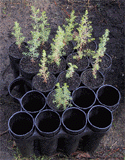
| After one or two years − depending on the size of the plants − the seedlings are carefully retrieved from the multipots and repotted in larger tubes (here
Deepots40). They are 25 cm deep (10 inches), allowing the roots to grow further down. The tubes are displayed on a tray with 20 places.
These pots are also used to sow large seeds like Torreya or Pinus maximartinezii and Pinus torreyana. Some Cupressus abramsiana after repotting. |

|
Text & Photos : © Arboretum de Villardebelle